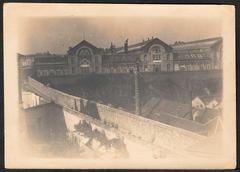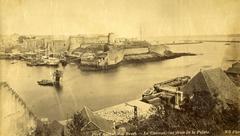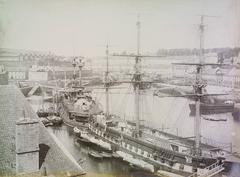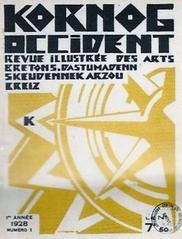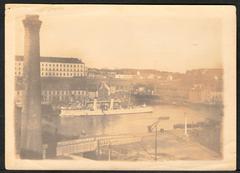Comprehensive Guide to Visiting Rue Saint-Malo, Brest, France
Date: 01/08/2024
Introduction
Rue Saint-Malo, situated in the heart of the Recouvrance district of Brest, France, stands as a poignant symbol of the city’s enduring resilience and cultural richness. This cobblestone street, miraculously spared from the extensive bombings of World War II, offers a rare glimpse into the architectural and social history of pre-war Brest. With its well-preserved 17th and 18th-century houses, traditional Breton stone buildings, and the historical Pontaniou Maritime Prison, Rue Saint-Malo is not just a relic of the past but a vibrant cultural hub maintained by the dedicated efforts of the Vivre la Rue association. This guide aims to provide a comprehensive overview of the street’s historical significance, practical visitor information, and the diverse cultural activities that make Rue Saint-Malo a must-visit destination for history enthusiasts and culture seekers alike. For a deeper dive into the historical and cultural essence of Brest, Rue Saint-Malo offers an unparalleled experience (Brest Metropole Tourisme, Wikipedia).
Table of Contents
- Introduction
- Historical Background
- Visitor Information
- Travel Tips and Nearby Attractions
- Cultural Events and Activities
- The Café Au Coin d’la Rue
- Historical Tours and Educational Programs
- FAQ
- The Future of Rue Saint-Malo
- Conclusion
Historical Background
Origins and Early History
Rue Saint-Malo is the last remaining vestige of pre-World War II Brest, having miraculously survived the extensive bombings that devastated much of the city during the war. This street offers a tangible connection to Brest’s past, providing a window into its architectural and social history.
The 17th Century: Asylum and Correctional Facility
In the 17th century, Rue Saint-Malo was home to an asylum known as La Madelaine, which was later transformed into a correctional facility for young girls called the Refuge Royal. This facility operated until 1782 when it was destroyed by a fire set by a resident.
The 19th Century: Maritime Prison
In 1807, an engineer named Trouille constructed the Pontaniou Maritime Prison along Rue Saint-Malo. This prison served as a detention center for sailors and maritime offenders until 1990, leaving a significant mark on the street’s history.
Preservation and Cultural Revival
Today, Rue Saint-Malo is preserved and revitalized by the association Vivre la Rue, which promotes cultural activities and maintains the historical integrity of the street. In 2013, the association established a cultural café called Au Coin d’la Rue, becoming a hub for local artists and events.
Architectural Significance
The street is lined with traditional Breton stone houses, characterized by thick stone walls, slate roofs, and small, shuttered windows. The preservation of these elements provides a connection to Brest’s past.
Visitor Information
Ticket Prices
Visiting Rue Saint-Malo is free of charge. However, certain events or guided tours organized by Vivre la Rue may have associated costs.
Opening Hours
The street is accessible to visitors at all times. Specific events at the cultural café Au Coin d’la Rue or guided tours have their own schedules, which can be found on the Vivre la Rue website.
Accessibility
Rue Saint-Malo’s cobblestone streets and historic buildings may pose challenges for visitors with mobility issues. However, efforts are made to accommodate all visitors during events and guided tours.
Travel Tips and Nearby Attractions
When visiting Rue Saint-Malo, consider exploring other historical sites in Brest such as the Brest Castle and the National Navy Museum. The nearby Recouvrance district also offers charming streets and local shops.
Cultural Events and Activities
Rue Saint-Malo hosts art exhibitions, musical performances, and historical reenactments. These events foster a sense of community and cultural pride among residents and visitors.
The Café Au Coin d’la Rue
Established in 2013, the café serves as a gathering place for locals and visitors, offering events such as poetry readings, book signings, and live music performances.
Historical Tours and Educational Programs
Vivre la Rue organizes guided tours and educational programs to promote the historical significance of Rue Saint-Malo. These tours provide insights into the street’s past and its former residents.
FAQ
Q: What are the opening hours of Rue Saint-Malo?
A: Rue Saint-Malo is accessible at all times. Specific event times can be found on the Vivre la Rue website.
Q: Are there any entry fees?
A: Visiting the street is free, but some events or tours may have costs.
Q: Is Rue Saint-Malo accessible for visitors with disabilities?
A: The cobblestone streets may pose challenges, but accommodations are made during events and guided tours.
The Future of Rue Saint-Malo
The future of Rue Saint-Malo appears bright, with plans to enhance cultural offerings and continue preservation efforts. These initiatives ensure that the street remains a cherished part of Brest’s cultural heritage.
Conclusion
Rue Saint-Malo stands as a testament to the resilience and cultural richness of Brest. Its historical significance, architectural beauty, and vibrant cultural scene make it a must-visit destination. The efforts of Vivre la Rue and the local community have ensured that this historic street continues to thrive. Whether you’re a history enthusiast, an art lover, or simply looking to immerse yourself in the local culture, Rue Saint-Malo has something to offer everyone.
Call to Action
For more information and updates, download the Audiala mobile app, check out other related posts, or follow us on social media.

